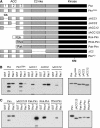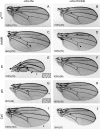A rho-binding protein kinase C-like activity is required for the function of protein kinase N in Drosophila development
- PMID: 17507675
- PMCID: PMC1950625
- DOI: 10.1534/genetics.107.072967
A rho-binding protein kinase C-like activity is required for the function of protein kinase N in Drosophila development
Abstract
The Rho GTPases interact with multiple downstream effectors to exert their biological functions, which include important roles in tissue morphogenesis during the development of multicellular organisms. Among the Rho effectors are the protein kinase N (PKN) proteins, which are protein kinase C (PKC)-like kinases that bind activated Rho GTPases. The PKN proteins are well conserved evolutionarily, but their biological role in any organism is poorly understood. We previously determined that the single Drosophila ortholog of mammalian PKN proteins, Pkn, is a Rho/Rac-binding kinase essential for Drosophila development. By performing "rescue" studies with various Pkn mutant constructs, we have defined the domains of Pkn required for its role during Drosophila development. These studies suggested that Rho, but not Rac binding is important for Pkn function in development. In addition, we determined that the kinase domain of PKC53E, a PKC family kinase, can functionally substitute for the kinase domain of Pkn during development, thereby exemplifying the evolutionary strategy of "combining" functional domains to produce proteins with distinct biological activities. Interestingly, we also identified a requirement for Pkn in wing morphogenesis, thereby revealing the first postembryonic function for Pkn.
Figures




Similar articles
-
The Drosophila Pkn protein kinase is a Rho/Rac effector target required for dorsal closure during embryogenesis.Genes Dev. 1999 May 1;13(9):1168-80. doi: 10.1101/gad.13.9.1168. Genes Dev. 1999. PMID: 10323867 Free PMC article.
-
Regulation of Rho and Rac signaling to the actin cytoskeleton by paxillin during Drosophila development.Mol Cell Biol. 2005 Feb;25(3):979-87. doi: 10.1128/MCB.25.3.979-987.2005. Mol Cell Biol. 2005. PMID: 15657426 Free PMC article.
-
Rho-kinase regulates tissue morphogenesis via non-muscle myosin and LIM-kinase during Drosophila development.BMC Dev Biol. 2006 Aug 1;6:38. doi: 10.1186/1471-213X-6-38. BMC Dev Biol. 2006. PMID: 16882341 Free PMC article.
-
Physiological roles of Rho and Rho effectors in mammals.Eur J Cell Biol. 2013 Oct-Nov;92(10-11):303-15. doi: 10.1016/j.ejcb.2013.09.002. Epub 2013 Oct 8. Eur J Cell Biol. 2013. PMID: 24183240 Review.
-
The role of rho family GTPases in development: lessons from Drosophila melanogaster.Mol Cell Biol Res Commun. 1999 May;1(2):87-94. doi: 10.1006/mcbr.1999.0119. Mol Cell Biol Res Commun. 1999. PMID: 10356356 Review.
Cited by
-
Development of an intracellularly acting inhibitory peptide selective for PKN.Biochem J. 2009 Dec 23;425(2):445-53. doi: 10.1042/BJ20090380. Biochem J. 2009. PMID: 19857203 Free PMC article.
-
Insulin receptor-mediated signaling via phospholipase C-γ regulates growth and differentiation in Drosophila.PLoS One. 2011;6(11):e28067. doi: 10.1371/journal.pone.0028067. Epub 2011 Nov 21. PLoS One. 2011. PMID: 22132213 Free PMC article.
-
The Rho target PRK2 regulates apical junction formation in human bronchial epithelial cells.Mol Cell Biol. 2011 Jan;31(1):81-91. doi: 10.1128/MCB.01001-10. Epub 2010 Oct 25. Mol Cell Biol. 2011. PMID: 20974804 Free PMC article.
-
Equivocal, explicit and emergent actions of PKC isoforms in cancer.Nat Rev Cancer. 2021 Jan;21(1):51-63. doi: 10.1038/s41568-020-00310-4. Epub 2020 Nov 11. Nat Rev Cancer. 2021. PMID: 33177705 Review.
-
PKN-1, a homologue of mammalian PKN, is involved in the regulation of muscle contraction and force transmission in C. elegans.J Mol Biol. 2011 Mar 25;407(2):222-31. doi: 10.1016/j.jmb.2011.01.039. Epub 2011 Jan 26. J Mol Biol. 2011. PMID: 21277858 Free PMC article.
References
-
- Amano, M., H. Mukai, Y. Ono, K. Chihara, T. Matsui et al., 1996. Identification of a putative target for Rho as the serine-threonine kinase protein kinase N. Science 271: 648–650. - PubMed
-
- Bayer, C. A., S. R. Halsell, J. W. Fristrom, D. P. Kiehart and L. von Kalm, 2003. Genetic interactions between the RhoA and Stubble-stubbloid loci suggest a role for a type II transmembrane serine protease in intracellular signaling during Drosophila imaginal disc morphogenesis. Genetics 165: 1417–1432. - PMC - PubMed
-
- Bourguignon, L. Y., P. A. Singleton and F. Diedrich, 2004. Hyaluronan-CD44 interaction with Rac1-dependent protein kinase N-gamma promotes phospholipase Cgamma1 activation, Ca(2+) signaling, and cortactin-cytoskeleton function leading to keratinocyte adhesion and differentiation. J. Biol. Chem. 279: 29654–29669. - PubMed
-
- Chen, G. C., P. Gajowniczek and J. Settleman, 2004. Rho-LIM kinase signaling regulates ecdysone-induced gene expression and morphogenesis during Drosophila metamorphosis. Curr. Biol. 14: 309–313. - PubMed
Publication types
MeSH terms
Substances
Grants and funding
LinkOut - more resources
Full Text Sources
Molecular Biology Databases
Miscellaneous

